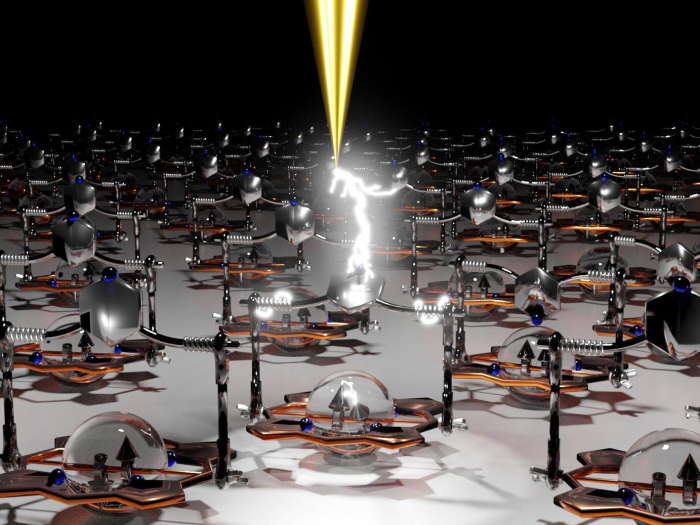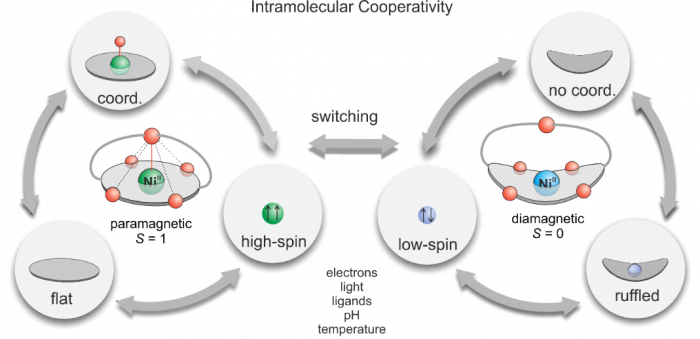Spintronics -or spin electronics- in contrast to conventional electronics, use the spin of electrons for sensing, information storage, transport, and processing. Potential advantages are nonvolatility, increased data processing speed, decreased electric power consumption, and higher integration densities compared to conventional semiconductor devices. Molecular spintronics aims for the ultimate step towards miniaturization of spintronics by striving to actively control the spin states of individual molecules.
Chemists and physicists at Kiel University joined forces with colleagues from DEIMOS beamline at SOLEIL and from SLS synchrotron to design, deposit and operate single molecular spin switches on surfaces. The newly developed molecules feature stable spin states and do not lose their functionality upon adsorption on surfaces. Their results are published in Nature Nanotechnology.
The spin states of the new compounds are stable for at least several days. "This is achieved by a design trick that resembles the fundamental electronic circuits in computers, the so-called flip-flops. Bistability or switching (between 0 and 1) is realized by looping the output signal back to the input", says experimental physicist Dr. Manuel Gruber from Kiel University. The new molecules have three properties that are coupled with each other in such a feedback loop: their shape (planar or flat), the proximity of two subunits, called coordination (yes or no), and the spin state (high-spin or low-spin). Thus, the molecules are locked either in one or the other state. Upon sublimation and deposition on a silver surface, the switches self-assemble into highly ordered arrays. Each molecule in such an array can be separately addressed with a scanning tunneling microscope and switched between the states by applying a positive or negative voltage.

Each molecule can be separately addressed with a scanning tunneling microscope and switched between the states by applying a positive or negative voltage.
© Jan-Simon von Glasenapp and Prof. Dr. Rainer Herges
"Our new spin switch realizes in just one molecule what takes several components (transistors and resistors) in conventional electronics. That’s a big step towards further miniaturization", Dr. Manuel Gruber und organic chemist Prof. Dr. Rainer Herges explain. The next step will be to increase the complexity of the compounds to implement more sophisticated operations.

The new molecule has three properties. Only two combinations of these properties are stable. Switched between the different states is achieved by applying tiny tunneling currents. © Prof. Dr. Rainer Herges
Molecules are the smallest constructions that can be designed and built with atomic precision and predictable properties. Their response to electrical or optical stimuli and their custom-designed chemical and physical functionality make them unique candidates to develop new classes of devices such as controllable surface catalysts or optical devices.
The contribution of DEIMOS beamline
The DEIMOS beamline has developed an experimental environment well suited for the study of molecular magnetism by X-ray Absorption Spectroscopy (XAS) and X-ray Magnetic Circular Dichroism (XMCD). This concerns not only the ultra-low temperature (down to 200mK) and the large magnetic field (up to 7T) of the end-station but also the possibility to fabricate in situ self-organized molecular ultra-thin films.
In the present case XAS and XMCD have been used on the studied system, of Ni-porphyrin deposited in Ag(111), to first qualify the spin transition from low spin to high spin. They have also be used to verify that the deposited molecular film keep their electronic structure upon sublimation on the Ag(111) surface.
The project was supported by CRC 677 „Function by Switching (German Research Foundation) and by the European Union’s Horizon 2020 research and innovation programme under grant no. 766726.
